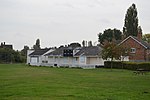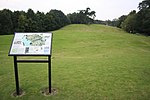Huntingdon and Godmanchester

Huntingdon and Godmanchester was a municipal borough in Huntingdonshire (and then Huntingdon and Peterborough) from 1961 to 1974.It was formed on 1 April 1961 by the merger of the boroughs of Huntingdon and Godmanchester. In 1974, under the Local Government Act 1972 the borough was abolished, and a successor parish formed within Huntingdon District, in the non-metropolitan county of Cambridgeshire. The parish had the status of a town, by resolution of the parish council. The borough was granted a coat of arms in 1963, which illustrated the union of the two towns. The shield was divided horizontally in a dovetail pattern to show the joining of two municipalities. At the top of the shield were two hunting horns for Huntingdon, and at the base a fleur-de-lis from the common seal of Godmanchester. The supporters on either side of the shield were described as a "medieval huntsman" and a "medieval oxherd", and they stood upon a representation of the old bridge at Huntingdon that linked the two towns. The motto was United We Advance. On 1 April 1982 the union of the two towns ended, with the formation of two separate civil parishes of Huntingdon and Godmanchester, each governed by a town council. In 1961 the parish had a population of 8821.
Excerpt from the Wikipedia article Huntingdon and Godmanchester (License: CC BY-SA 3.0, Authors, Images).Huntingdon and Godmanchester
Causeway, Huntingdonshire Godmanchester
Geographical coordinates (GPS) Address Nearby Places Show on map
Geographical coordinates (GPS)
| Latitude | Longitude |
|---|---|
| N 52.319 ° | E -0.175 ° |
Address
Causeway 4
PE29 2HB Huntingdonshire, Godmanchester
England, United Kingdom
Open on Google Maps










